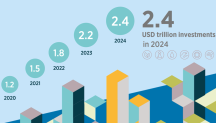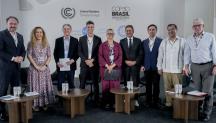

Solar PV Employs More Women Than Any Renewables
Newsletter

New IRENA report shows that solar PV industry has the highest share of full-time women employees, reaching 40% in 2021.
Milan, Italy/Abu Dhabi, United Arab Emirates, 29 September 2022 – Solar photovoltaic (PV) has emerged to be the leading employer in the renewable energy sector, both in global number of employees and in gender balance. In 2021, the solar PV industry employs 4.3 million people—one-third of all renewable energy jobs worldwide. Women account for 40% of this number. It is almost double the share of women employed in the wind industry (21%) and the oil and gas sector (22%). It is also higher than the average share of women employed in all renewables sectors, which is 32%.
The International Renewable Energy Agency (IRENA)’s new report, Solar PV: A Gender Perspective, finds that women fare best in solar PV manufacturing, representing 47% of the workforce. Service providers and developers follow with 39% and 37%, respectively, while solar PV installers perform the least, with barely 12% of the segment’s workforce.
“A just and inclusive energy transition is not only about energy access. It is about making sure everyone is included and benefits from the process,” says Francesco La Camera, Director-General of IRENA. “The findings of our new report are promising and confirm renewable energy’s great potential as an equal employer, but they also signal the need to step up our efforts to pave the way for more women to lead the energy transition and shape our shared future.”

Presented at the 8th World Conference on PV Energy Conversion in Milan today, the report highlights the need for equal opportunities for women in technical positions in science, technology, engineering and mathematics (STEM) and in other professional fields, where they hold 38% and 32% of positions, respectively. Additionally, there is a wide space for women to take over more decision-making positions, as they currently hold 30% of managerial jobs and barely 13% of senior management posts in the solar PV industry.
Decentralised solar PV, on the other hand, seems to offer significant opportunities, as the off-grid solar PV value chain engages women both in delivering solutions and as beneficiaries. Driven in part by off-grid solar PV deployments, women account for 35% of other non-technical positions such as marketing, sales, distribution, and product assembly and installation.
Based on IRENA’s global survey of some 1,300 individuals and organisations conducted in 2021, the report evaluates the role of women in the solar PV industry, highlighting barriers and opportunities. The most prominent barriers are perceptions of gender roles, lack of fair and transparent policies, as well as cultural and social norms that shape behaviour.
Raising awareness on gender equality, improving national as well as workplace policies, offering more training, networking opportunities and access to mentorships are all critical steps to level the playfield for women in the sector. These efforts are needed not only to increase the participation of women, but also to diversify the workforce by including the visions, talents and skills of all minority groups.
This is the third report in the Gender Perspective series, which is an integral part of IRENA’s extensive research work on the effects of renewable energy deployment during energy transitions. The initial focus on employment creation and skills was expanded over time to cover other socio-economic elements such as gross domestic product, broader measures of welfare, local economic value creation, improved livelihoods and gender-differentiated impacts.
See the visual story: A Gender Perspective on Solar Employment.
Read the full report: Solar PV: A Gender Perspective.
Read the previous reports: Renewable Energy: A Gender Perspective and Wind Energy: A Gender Perspective.




